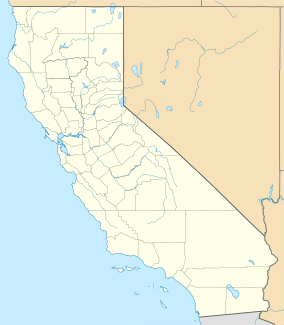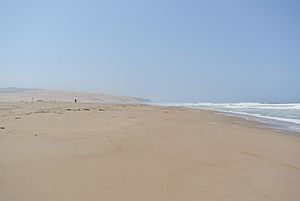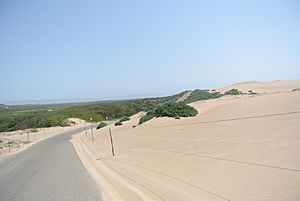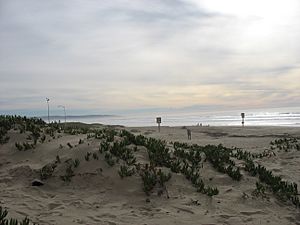Guadalupe-Nipomo Dunes facts for kids
Quick facts for kids Guadalupe-Nipomo Dunes |
|
|---|---|
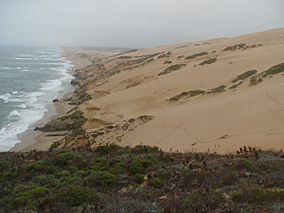
A view of the Guadalupe-Nipomo Dune complex from its southern tip at Mussel Rock.
|
|
| Location | San Luis Obispo County, Santa Barbara County, USA |
| Nearest city | Oceano and Guadalupe, California |
| Area | 22,000 acres (89 km2) |
| Governing body | Federal, state, local & private |
| Designated: | 1974 |
The Guadalupe-Nipomo Dunes is a huge area of sand dunes along the Central Coast of California. It stretches for about 18 miles (29 km) from southern San Luis Obispo County to northern Santa Barbara County. It is the biggest dune system south of San Francisco and the second largest in all of California.
This special place is home to a unique ecosystem and many rare plants and animals. Some of these species are even endangered or threatened. To protect this important environment, much of the Dunes area is set aside for conservation. It is also recognized as a National Natural Landmark, which means it's a nationally important natural site.
Parts of the Dunes are also used for fun activities like camping and off-highway vehicle (OHV) riding. Many different groups own the Guadalupe-Nipomo Dunes. These include local counties, California State Parks, the U.S. Fish and Wildlife Service, and private groups.
Contents
Exploring the History of the Dunes
The first people known to live in the Guadalupe-Nipomo Dunes were Native Americans from the Chumash tribe. Early Spanish explorers saw their settlements. However, Europeans did not travel through the Dunes until 1769.
First European Visitors and the Skinny Bear
From September 2 to 4, 1769, explorers from Don Gaspar de Portolà's group stayed in the Dunes. They shot a very thin bear near a lake, which is now called Oso Flaco Lake. After eating the bear, two explorers became sick. The Chumash people had poisoned the bear to protect themselves from dangerous wildlife. This event gave the lake its name: Oso Flaco, which means "Skinny Bear" in Spanish.
Hollywood in the Dunes: Movies and Buried Sets
In 1923, a famous movie called The Ten Commandments was filmed in the Dunes. This epic movie was directed by Cecil B. DeMille. After filming, the huge sets that looked like ancient Egypt were taken apart and buried right there. This was done to stop them from being used again.
Even today, these sets are still buried under the sand. Some parts have been found and are shown at The Dunes Visitor Center. Sometimes, as the sand shifts, more pieces appear! More recently, parts of Beyoncé's music film Black Is King were also filmed here in 2019.
The Dunites and Oil Discovery
From the 1920s to the 1940s, a group of artists, writers, and unique people called the "Dunites" lived in the Dunes. They believed the Dunes had a special creative energy. They even published their own magazine called "The Dune Forum."
Around the same time, oil companies started buying land in the Dunes. In 1948, oil was found! The oil company Unocal began operating the Guadalupe Oil Field in the 1950s. Over the next 40 years, about 18 million gallons of petroleum leaked under the Dunes.
In 1994, Unocal admitted to the spill and started cleaning up the area. This cleanup covers about 2,700 acres (11 km²) in San Luis Obispo County. As of 2015, the cleanup and restoration work was still expected to continue for at least another 10 years.
Protecting the Dunes: Conservation Efforts
Efforts to protect the natural environment of the Dunes began in the 1970s. A big change was limiting OHVs to a special area called the Oceano Dunes State Vehicular Recreation Area. This allowed other parts of the Dunes to be restored by conservation groups. This work to restore the dunes is still going on today.
Air Quality and Dust in the Dunes
The Dunes have been part of ongoing discussions about air quality. Towns downwind of the dunes sometimes experience reduced air quality due to dust. People living there have reported breathing problems when dust levels are high.
Studies have shown that while some dust pollution is natural, off-highway vehicle activity makes it worse. The San Luis Obispo County Air Pollution Control District has been studying this issue since 1995.
Geography and Environment of the Dunes
The Guadalupe-Nipomo Dunes were formed in a few ways. Beach sand was blown inland by the wind. Also, the Santa Maria River brought sediment to the coast. Dune building started about 18,000 years ago.
This Dune System has the tallest dunes on the entire western coastline of the United States. Mussel Rock Dune is the highest, reaching about 500 feet (150 meters) tall. Another special natural feature is Oso Flaco Lake, a freshwater lake found right in the middle of the Dunes.
Plants and Animals: Life in the Sand
Even though the Dunes are mostly moving sand with little water and nutrients, they are full of different flora (plants) and fauna (animals). There are at least 18 endangered species of plants living here. Dune plants must be tough to survive being buried by sand, salt spray, strong winds, and bright sun.
The Nipomo Mesa lupine is a plant found only in these dunes. It grows in a narrow strip of sand dunes.
Dune Habitats and Plant Adaptations
The dunes have two main types of habitats: uplands and wetlands. Uplands include the sandy beaches, fore dunes, and back dunes. Dunes can form in different ways. Primary Foredunes run parallel to the shore and have few plants. Parabolic dunes are "U" shaped and grow away from the shore, with plants on their ridges. Moving sand sheets are areas where sand is always shifting, making it hard for plants to grow.
The fore dunes start at the high tide line. Only low-growing plants with deep roots, like sand verbena, can live here. Strong winds, salt spray, and lots of sand make it hard for other plants. Plants in the dunes adapt to high winds. Some grow close to the ground, while others grow in a "Krummholz" shape, which means they are stunted and twisted by the wind.
The back dunes are behind the fore dunes. They are more stable and covered with plants. These areas have many shrubs like mock heather, dune lupine, coastal buckwheat, and blochman's senecio. Sandy beaches are too harsh for any plants to survive.
Wetlands are areas with water, such as salt marshes, freshwater marshes, swamps, and mudflats. Plants here are adapted to changing conditions, including high salt levels and extreme temperatures. To deal with high salt, plants might have deep roots to reach water, thick outer layers to prevent water loss, or fleshy leaves that store water.
Invasive Plants: A Threat to Native Species
Unfortunately, some Weeds have been brought into the Dunes, both on purpose and by accident. These non-native plants threaten the native plant life. For example, European beach grass is taking over and choking out native dune grasses. This grass grows even better when buried by sand, which helps it spread more.
Animals of the Dunes
Many different animals call the dunes home. Over 200 types of birds live here, including the western snowy plover, American peregrine falcon, California brown pelican, and California least tern.
Other animals that depend on the dunes include the california red-legged frog, coast garter snake, deer, black bear, bobcats, and mountain lions. You can also find beetles, butterflies, lizards, and both saltwater and freshwater fish in the dunes.
Western Snowy Plover: Protecting a Threatened Bird
The western snowy plover (Charadrius nivosus) is a small bird listed as threatened under the Endangered Species Act (ESA) since 1993. This means it needs special protection. Some people believe that off-road vehicle use harms the plover's ability to have babies.
However, the number of western snowy plover nests has actually grown a lot! From 16 nests in 1993, it increased to 172 nests in 2011. Even during busy times like Memorial Day weekend, many plover nests are found near the open vehicle area at Oceano Dunes. This might mean that human presence helps keep predators away, offering the plovers a safe place.
Studies show that plovers prefer to nest on open sand. This can put their nests at risk of being crushed by vehicles or hikers. The Santa Lucia Chapter of the Sierra Club suggested putting up fences all year to protect plover habitats. But the Oceano Dunes State Vehicular Recreation Area said no. Soon after, a plover was killed by an off-road vehicle in an area that was suggested for fencing.
The Sierra Club then sued the State Parks. They claimed the parks were not protecting the snowy plover, California least tern, and steelhead trout enough. As a result of the lawsuit, State Parks agreed to research, raise money, and create an education program about the snowy plover.
The Park also has to close an extra half-mile of the beach between March and October, which is the plover's breeding season. They must also find new ways for vehicles to avoid crossing Arroyo Grande Creek, as it is home to steelhead trout.
Management and Uses of the Dunes
The Guadalupe-Nipomo Dunes Complex has several different areas. Each area is managed by different groups and used for various purposes.
- Pismo State Beach
- North Beach Campgrounds is at the northern end of the Dunes. It is run by the California Department of Parks and Recreation. Visitors can enjoy family camping, surfing, swimming, surf fishing, and hiking.
- Oceano Campgrounds is further south, near the town of Oceano. It is also run by California State Parks and has a nature museum.
- The Oso Flaco Lake Natural Area is part of the Oceano Dunes State Vehicular Recreation Area. Visitors can walk along a mile-long boardwalk that goes over the creek and Oso Flaco Lake to the ocean.
- The California Office of Environmental Health Hazard Assessment has given advice about eating fish from Oso Flaco Lake. It's best not to eat them due to high levels of certain chemicals.
- The Dunes Center works to protect the Dunes ecosystem through education and research. It is located in the city of Guadalupe in a restored 1910 house. The Center has exhibits about the natural and cultural history of the dunes.
- The Guadalupe-Nipomo Dunes National Wildlife Refuge (NWR) covers 2,553 acres (1,033 ha) in the middle of the Dunes Complex. It includes 1.8 miles (2.9 km) of beach. The U.S. Fish and Wildlife Service created the NWR in 2000. It has some of the most untouched habitats in the dunes. It is home to over 120 rare plants and animals, like the La Graciosa thistle, surf thistle, and California red-legged frog. Access is limited and requires a long hike. Dogs are not allowed.
- Rancho Guadalupe Dunes County Park is at the southern end of the dunes. It is owned by Santa Barbara County Parks. This park has the least damage from invasive plants. Visitors can enjoy bird and whale watching, fishing, and hiking. There is also a picnic area and an information kiosk. Some areas have seasonal restrictions during bird nesting season (March 1 to October 1).
- Oceano Dunes State Vehicular Recreation Area (SVRA) is south of Oceano. It has five and a half miles of beach open for vehicles. A large area of sand dunes is open for off-highway vehicle (OHV) use, including quads, dirt-bikes, and four-wheel drive vehicles. It is the only state park in California where people can legally drive on the beach.
This park is very popular, attracting 2 million visitors each year. Guests can even camp right on the beach. Other activities include horseback riding and bird watching. The Oceano Dunes has been a favorite spot for over 100 years. The county also earns money from off-roading tourism.
The Oceano State Vehicular Recreation Area takes steps to protect wildlife. They fence off certain areas from people and vehicles. They also have rules for visitors, such as a 15 mph (24 km/h) speed limit. Visitors must not enter closed areas and keep dogs on a leash. They also need to remove trash that could attract predators. During busy holidays, extra rangers are there to make sure rules are followed.
Who Owns the Land?
For 25 years, San Luis Obispo County let the State Department of Parks and Recreation use 584 acres (2.36 km²) of the Dunes for free. When this agreement ended in 2008, the County Board of Supervisors had choices. They could sell the land, renew the free deal, or ask the state to pay rent.
To decide whether to sell the land to the state, two public meetings were held in April 2007. To sell property, four-fifths of the supervisors must agree. But to renew a lease, only a majority vote is needed.
State Parks offered to pay $4.86 million for nearly 584 acres (2.36 km²) of beachfront property. This land is right in the middle of the Oceano Dunes State Vehicular Recreation Area. Many groups wanted the land sold to State Parks.
Currently, the Oceano Dunes State Vehicular Recreation Area uses one-third of the beach for off-road vehicles. Off-roaders were worried that if the county kept the land, they might add more rules. The land available for vehicles had already shrunk from 15,000 acres (61 km²) to 1,500 acres (6.1 km²).
The State wanted to buy the land to make sure there would always be a place for off-road vehicles. They said not all the land would be used for vehicles and camping. Part of it would be set aside as protected areas, as the County wanted. However, on April 17, 2007, the San Luis Obispo Board of Supervisors voted 4-0 not to sell the 584 acres (2.36 km²) of land to the State.
Images for kids


